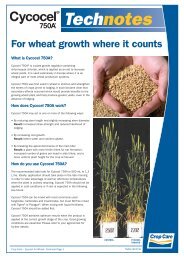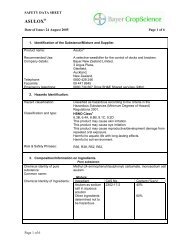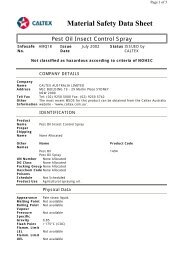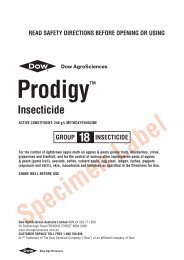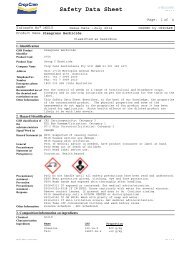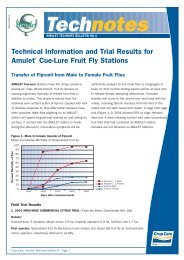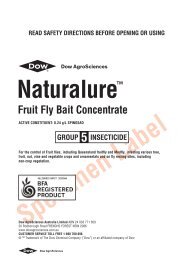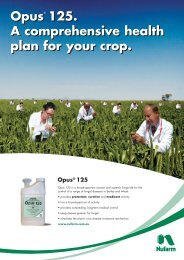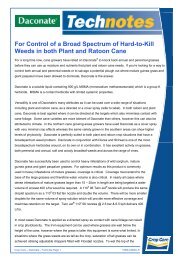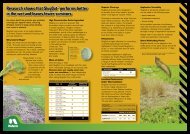LI 700 Technical brochure horticulture - Pest Genie
LI 700 Technical brochure horticulture - Pest Genie
LI 700 Technical brochure horticulture - Pest Genie
- No tags were found...
You also want an ePaper? Increase the reach of your titles
YUMPU automatically turns print PDFs into web optimized ePapers that Google loves.
<strong>LI</strong> <strong>700</strong>®3SURFACTANT - GIVE YOUR CROP THE ADJUVANTAGE<strong>LI</strong> <strong>700</strong>Surfactant – Penetrant – Acidifier – Aid for Droplet ManagementMore than 200 adjuvants are registered in Australia. Many of them have little or no empirical datasupporting their label claims. In contrast, <strong>LI</strong> <strong>700</strong> is one of the most researched adjuvantsin the world and its multifunctional properties are well understood.<strong>LI</strong> <strong>700</strong> is made from a blend of Lecithin oil, propionic acid (a weak organic acid) and varioussurfactants. This combination of ingredients gives <strong>LI</strong> <strong>700</strong> a wide range of properties that can greatlyenhance pesticide performance in several ways.Spreading and wettingThe majority of pesticides prefer a slightly acidic milieuin the range of pH 6 or less. Some plants, especiallybroadleaf weeds have surfaces that are naturally highin pH (alkaline) that hinders the uptake of weak acidicpesticides. The acidifying properties of <strong>LI</strong> <strong>700</strong> helpto create a more favourable pH environment for thepesticide on the leaf surface. With its penetratingproperties <strong>LI</strong> <strong>700</strong> enhances speed and overall uptakeof products and increases efficacy and rainfastness.Enhancement of RainfastnessFor example, in a trial conducted in citrus <strong>LI</strong> <strong>700</strong>enhanced the uptake of manganese, zinc and iron(Figure 2). There was no effect on copper uptake.Copper products generally prefer a higher pH and shouldnot be mixed with <strong>LI</strong> <strong>700</strong>.In a different trial in citrus <strong>LI</strong> <strong>700</strong> increased the uptakeof foliar urea when compared to the use of a non-ionicsurfactant (Figure 3). The indirect urea uptakemeasurement of chlorophyll reading shows an increase inphotosynthetic activity shortly after application.Without adjuvant Cycocel showed limited uptakeand movement. The treatment containing <strong>LI</strong> <strong>700</strong>demonstrated the best uptake, resulted in the besttranslocation and was the only treatment whereCycocel moved down to the base of the leaf.Another PGR extensively used in table grapes isGibberellic Acid (GA). Trials indicate that at low<strong>LI</strong> <strong>700</strong> rates of 0.08 - 0.125% the use of <strong>LI</strong> <strong>700</strong>increased the uptake of GA, resulted in better sizedberries and less compact bunches (Figure 8 and 9).No crop effect was observed.<strong>LI</strong> <strong>700</strong> reduces the surface tension of spray droplets, allowing them to spread over a greater surfacearea which greatly increases coverage. In this regard <strong>LI</strong> <strong>700</strong> is not different to a typical adjuvant.<strong>LI</strong> <strong>700</strong> does more. Its acidifying properties protect many pesticides from chemical degradation in thetank and provide a more favourable pH environment on the leaf surface for their uptake. Itsmultifunctional chemistry opens cuticle pathways in the waxy layer of the plant and increasespenetration and translocation to the target sites.II7Figure 5. Apples - changes of calcium levels of Cox Orange aftercalcium chloride treatment. <strong>LI</strong> <strong>700</strong> at 0.3% v/v.Source: Geelen, 1997.The uptake of boron was increased in Broccoliwhen Borosol was used with <strong>LI</strong> <strong>700</strong> (Figure 6).Chemical HydrolysisAlkaline hydrolysis is the chemical break downof pesticides in spray solutions that can occur if the waterused for spraying is alkaline. In Australia, most water usedfor spraying has varying degrees of alkalinity. Alkalinehydrolysis is affected by the susceptibility of the product,the pH of the water, duration of contact and temperature.A most alarming example of rapid breakdown is theinsecticide dimethoate. It loses half of its activity in only45 minutes when mixed with water pH 9. Table 1 showssome examples of pesticides affected by alkalinehydrolysis. Minimising breakdown can be achieved byacidifying the spray solution with <strong>LI</strong> <strong>700</strong> to the optimumpH level of 4 to 6. Unlike other acids that can over acidifythe spray solution, the propionic acid in <strong>LI</strong> <strong>700</strong> is a weakacid that will not lower the pH beneath the safe levelof pH 3.5. This becomes especially relevant for a dropletdrying on the leaf surface. As the water is evaporating theconcentration of acid will increase. Droplets containing<strong>LI</strong> <strong>700</strong> will remain buffered at a safe pH level around 3.5.PenetrationAt rates of 250 mL/100 L and above the lecithinchemistry temporarily loosens the joints betweenoverlapping wax plates on the leaf surface. This enhancesthe uptake of herbicides, foliar fertilisers, fungicides andplant growth regulators. Unlike many other oils thedisruption of the waxy layer by <strong>LI</strong> <strong>700</strong> has little sideeffects. The cuticular disruption by <strong>LI</strong> <strong>700</strong> is onlytemporary and the wax will reset to near normal(Picture 1). Therefore, in many horticultural situations<strong>LI</strong> <strong>700</strong> is soft on the crop when compared to otherpenetrating adjuvants.Normal structureundisturbedStructure after exposureto petroleum oil-basedadjuvantStructure after exposureto <strong>LI</strong> <strong>700</strong>Figure 1. Wild radish, effect of <strong>LI</strong> <strong>700</strong> on rainfastness of Glyphosate450CT at 1.2 L/ha. Source: A. Wells, Plant Protection QuarterlyVol 4(4) 1989.Faster penetration into the plant means less exposureto detrimental weather conditions. This effect of <strong>LI</strong> <strong>700</strong> isdemonstrated in Figure 1. <strong>LI</strong> <strong>700</strong> aids in the quick uptakeof glyphosate into the waxy layer of radish and increasesthe rainfastness dramatically. In the same study similarresults were observed on wild oats, annual ryegrass andhedge mustard.Increase in Uptake of Foliar Fertilisers<strong>LI</strong> <strong>700</strong> enhances the uptake of foliar fertilisers in a widerange of horticultural crops. Trials have shown improveduptake of iron, zinc, manganese and boron whenformulated as salt, chelate or sulphate.Figure 3. Citrus - increased uptake of foliar applied urea.Source: Yuma, 1998.Especially the uptake of manganese benefits from the useof <strong>LI</strong> <strong>700</strong> as a further trial in onions shows (Figure 4). <strong>LI</strong><strong>700</strong> increased the uptake of the chelated formulation aswell as the sulphate form.Figure 4. Onions - increased uptake of manganese into plant whenapplied as a chelate or sulphate foliar application. <strong>LI</strong> <strong>700</strong> at 0.5% v/v.Source: Asselin, 1999.Figure. 6. Broccoli - increased uptake of boron. <strong>LI</strong> <strong>700</strong> at0.5% v/v . Source: Fafard, 1999Translocation<strong>LI</strong> <strong>700</strong> does not only affect the uptake of chemicalsinto the plant but also their translocation inside theplant. For example, Cycocel ®2 77A (chlormequat)a Plant Growth Regulator (PGR) for grapevines haslimited mobility in the plant. Figure 7 shows theresults of an experiment in which chlormequat wasonly applied to the middle of a cereal leaf.Figure 8. Table grapes - increased berry size in ThompsonSeedless. Source: Loveland Industries.Figure 9. Table grapes - increased stem and branch length inThompson Seedless bunches. Source: Loveland Industries.Dimethoate, Rogor® 9 , Sabotuer®Bugmaster® 4Imidan® 8Kelthane® 2Dipterex® 4 , Lepidex 500Fastac®Duo, Dominex®Rovral®Picture 1. Annual ryegrass (Lolium rigidum) waxy cuticular.Figure 2. Citrus - increased foliar trace element uptake with <strong>LI</strong> <strong>700</strong> at1.4 L/ha, Zn-Mg 18x15 at 5.6 kg/ha, MKP(0-52-34) at 11.2 kg/ha.Source: Gless, 2000In apples <strong>LI</strong> <strong>700</strong> increases the calcium concentration infruit and leaves when used with calcium chloride (Figure5). No phytotoxic effect was observed. When comparedto standard non-ionic surfactants the increased uptake ofcalcium resulted in a significant 24% reductionof bitter pit.Figure 7. Effect of <strong>LI</strong> <strong>700</strong> on uptake and translocation ofchlormequat in a wheat leaf. Source: University of Essex.



